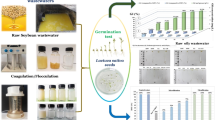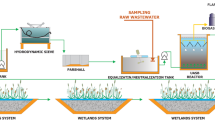Abstract
Olive-mill wastewater (OMW) is a by-product effluent of olive oil extraction process that is produced in large amount in the Mediterranean region. OMW is believed to induce phytotoxic effect on organisms including seed germination and plant growth. The objective of this study was to evaluate the impact of untreated and treated OMW with different techniques on seed germination of barley (Hordeum vulgare L.). The following treatments were investigated: (1) tap water (control); (2) OMW treated by aerobic biological technology in a Jacto Reactor (JR); (3) OMW treated by solar fenton oxidation (SFO); (4) OMW treated by microfiltration followed by nanofiltration (MF+NF); (5) OMW treated by microfiltration followed by reverse osmosis (MF+RO) process; (6) diluted OMW with tap water (25 % OMW); (7) diluted OMW with tap water (50 % OMW); (8) diluted OMW with tap water (75 % OMW); and (9) untreated OMW (100 % OMW). A germination test was conducted in an incubator at temperature of 23 ∘C. In each petri dish, a filter paper was mounted and ten seeds of barley were placed on the filter paper. Five milliliter of water were added to each petri dish. The seed germination was determined by counting the number of germinated seeds to calculate the percentage of germination (G %). Germination rate index (GRI), seed vigor index (SVI), and phytotoxicity index (PI) were also calculated. Then, the dry weights and lengths of the shoots and the roots of the germinated seeds were measured. The results show that 100, 75, and 50 %OMW were very phytotoxic and completely prohibited seed germination. However, phytotoxicity decreased significantly following treatments of OMW with all techniques investigated and by the 25 % OMW dilution, as results of removing the phenols and other phytotoxic organic compounds from the OMW or by diluting it. This was evidenced by relative enhancement of the dry weights and lengths of shoot and root as well as the G %, GRI, SVG, and PI. It was concluded that if OMW will be used for irrigating crops, it has to be first treated or diluted with tap water at a ratio of 1:3 OMW:water at least. The most efficient treatment techniques in reducing the phytotoxicity of OMW were the MF+RO, followed by SFO and JR.


Similar content being viewed by others
References
Aggelis G, Iconomou D, Christou M, Bokas D, Kotzailias S, Christou G, Tsagou V, Papanikolaou S (2003) Phenolic removal in a model olive oil mill wastewater using pleurotus ostreatus in bioreactor cultures and biological evaluation of the process. Water Res 37(16):3897–3904
Akbari G, Sanavy SAMM, Yousefzadeh S (2007) Effect of auxin and salt stress (nacl) on seed germination of wheat cultivars (triticum aestivum l.) Pak J Biol Sci 10(15):2557–2561
Altieri R, Esposito A (2008) Olive orchard amended with two experimental olive mill wastes mixtures: effects on soil organic carbon, plant growth and yield. Bioresour Technol 99(17):8390–8393
Ansari O, Sharif-Zadeh F (2012) Osmo and hydro priming improvement germination characteristics and enzyme activity of mountain rye (secale montanum) seeds under drought stress. J Stress Physiol Biochem 8(4):253–261
APHA (1992) Standard mehods for the exmnination of water and wastewater, 18th Edition. American Public Health Association, Washington
Arienzo M, Capasso R (2000) Analysis of metal cations and inorganic anions in olive oil mill waste waters by atomic absorption spectroscopy and ion chromatography. detection of metals bound mainly to the organic polymeric fraction. J Agric Food Chem 48(4):1405–1410
Aviani I, Raviv M, Hadar Y, Saadi I, Laor Y (2009) Original and residual phytotoxicity of olive mill wastewater revealed by fractionations before and after incubation with pleurotus ostreatus. J Agric Food Chem 57(23):11254–11260
Ayoub S, Al-Absi K, Al-Shdiefat S, Al-Majali D, Hijazean D (2014) Effect of olive mill wastewater land-spreading on soil properties, olive tree performance and oil quality. Sci Hortic 175:160–166
Ben-Gal A, Borochov-Neori H, Yermiyahu U, Shani U (2009) Is osmotic potential a more appropriate property than electrical conductivity for evaluating whole-plant response to salinity Environ Exp Bot 65(2–3):232–237
Bliss RD, Platt-Aloia KA, Thomson WW (1986) Osmotic sensitivity in relation to salt sensitivity in germinating barley seeds. Plant Cell Environ 9(9):721–725
Bottino A, Capannelli G, Comite A, Ferrari F, Jezowska A, Firpo R (2015) Treatment of olive mill wastewater through integrated pressure driven membrane processes
Casa R, D’Annibale A, Pieruccetti F, Stazi S, Sermanni GG, Cascio BL (2003) Reduction of the phenolic components in olive-mill wastewater by an enzymatic treatment and its impact on durum wheat (triticum durum desf.) germinability. Chemosphere 50(8):959–966
Ellis R, Roberts E (1980) Towards a Rational Basis for Testing Seed Quality. Butterworths, London
Eusébio A, Mateus M, Baeta-Hall L, Sàágua MC, Tenreiro R, Almeida-Vara E, Duarte JC (2007) Characterization of the microbial communities in jet-loop (jacto) reactors during aerobic olive oil wastewater treatment. Int Biodeterior Biodegrad 59(3):226–233
Fricke W, Akhiyarova G, Wei W, Alexandersson E, Miller A, Kjellbom P O, Richardson A, Wojciechowski T, Schreiber L, Veselov D, Kudoyarova G, Volkov V (2006) The short-term growth response to salt of the developing barley leaf. J Exp Bot 57(5):1079–1095
González M, Moreno E, Quevedo-Sarmiento J, Ramos-Cormenzana A (1990) Studies on antibacterial activity of waste waters from olive oil mills (alpechin): inhibitory activity of phenolic and fatty acids. Chemosphere 20(3–4):423–432
Hampson CR, Simpson GM (1990) Effects of temperature, salt, and osmotic potential on early growth of wheat (triticum aestivum). i. germination. Can J Bot 68(3):524–528
Hanifi S, Hadrami I (2008) Phytotoxicity and fertilising potential of olive mill wastewaters for maize cultivation. Agron Sustain Dev 28(2):313–319
Huang J, Redmann R E (1995) Salt tolerance of hordeum and brassica species during germination and early seedling growth. Can J Plant Sci 75(4):815–819
Khan M, Gul B, Weber D (2002) Seed germination in relation to salinity and temperature in sarcobatus vermiculatus. Biol Plant 45(1):133–135
Khodarahmpour Z (2011) Screening maize (zea mays l.) hybrids for salt stress tolerance at germination stage. Afr J Biotechnol 10(71):15959–15965
Komilis DP, Karatzas E, Halvadakis CP (2005) The effect of olive mill wastewater on seed germination after various pretreatment techniques. Aust J Environ Manag 74(4):339–348
Kopittke PM, Blamey FPC, Asher CJ, Menzies NW (2010) Trace metal phytotoxicity in solution culture: a review. J Exp Bot 61(4):945–954
Krmz S, Bell RW (2012) Responses of barley to hypoxia and salinity during seed germination, nutrient uptake, and early plant growth in solution culture. J Plant Nutr Soil Sci 175(4):630–640
Lanciotti R, Gianotti A, Baldi D, Angrisani R, Suzzi G, Mastrocola D, Guerzoni M (2005) Use of yarrowia lipolytica strains for the treatment of olive mill wastewater. Bioresour Technol 96(3):317–322
Laor Y, Saadi I, Raviv M, Medina S, Erez-Reifen D, Eizenberg H (2011) Land spreading of olive mill wastewater in israel: current knowledge, practical experience, and future research needs. Israel J Plant Sci 59:39–51
Mekki A, Dhouib A, Sayadi S (2007) Polyphenols dynamics and phytotoxicity in a soil amended by olive mill wastewaters. J Environ Manag 84(2):134–140
Mekki A, Dhouib A, Sayadi S (2013) Effects of olive mill wastewater application on soil properties and plants growth. Int J Recycl Org Waste Agric 2(1):1–7
Mensuh J, Akomeah P, Ikhajiagbe B, Ekpekurede O (2006) Effects of salinity on germination, growth and yield of five groundnut genotypes. Afr J Biotechnol 5(20):1973–1979
Michael I, Panagi A, Ioannou LA, Frontistis Z, Fatta-Kassinos D (2014) Utilizing solar energy for the purification of olive mill wastewater using a pilot-scale photocatalytic reactor after coagulation-flocculation. Water Res 60:28–40
Motamedi M, Khodarahmpour Z, Ahakpaz F (2013) Influence of salicylic acid pretreatment on germination and seedling growth of wheat (triticum aestivum l.) cultivars under salt stress. Int J Biosci 3(8):226–233
Murillo-Amador B, López-Aguilar R, Kaya C, Larrinaga-Mayoral J, Flores-Hernández A (2002) Comparative effects of nacl and polyethylene glycol on germination, emergence and seedling growth of cowpea. J Agron Crop Sci 188(4):235–247
Muscolo A, Sidari M, Mallamaci C, Attina E (2010) Effects of olive mill wastewater on seed germination and seedling growth. Terr Aquat Environ Toxicol 4(1):75–83
Naseri R, Emami T, Mirzaei A, Soleymanifard A (2012) Effect of salinity (sodium chloride) on germination and seedling growth of barley(hordeum vulgare l.) cultivars. Int J Agric Crop Sci 4(13):911–917
Okçu G, Kaya M, Atak M (2005) Effects of salt and drought stresses on germination and seedling growth of pea (pisum sativum l.) Turk J Agric For 29:237–242
Orchard T (1977) Estimating the parameters of plant seedling emergence. Seed Sci Technol 5(1):61–69
Ouzounidou G, Asfi M (2012) Determination of olive mill wastewater toxic effects on three mint species grown in hydroponic culture. J Plant Nutr 35(5):726–738
Patade V, Maya K, Zakwan A (2011) Seed priming mediated germination improvement and tolerance to subsequent exposure to cold and salt stress in capsicum. Res J Seed Sci 4(3):125–136
Piotrowska A, Rao MA, Scotti R, Gianfreda L (2011) Changes in soil chemical and biochemical properties following amendment with crude and dephenolized olive mill waste water (omw). Geoderma 161(1–2):8–17
Saadi I, Laor Y, Raviv M, Medina S (2007) Land spreading of olive mill wastewater: effects on soil microbial activity and potential phytotoxicity. Chemosphere 66(1):75–83
Saadi I, Raviv M, Berkovich S, Hanan A, Aviani I, Laor Y (2013) Fate of soil-applied olive mill wastewater and potential phytotoxicity assessed by two bioassay methods. J Environ Qual 42(6):1791–1801
Sabir P, Ashraf M (2005) Screening of local accessions of panicum miliaceum l for salt tolerance at the seedling stage using biomass production and ion accumulation as selection criteria. Pak J Bot 39(5):1655–1661
Sayadi S, Allouche N, Jaoua M, Aloui F (2000) Detrimental effects of high molecular-mass polyphenols on olive mill wastewater biotreatment. Process Biochem 35(7):725–735
Singh H (2006) Fungal Degradation of Polychlorinated Biphenyls and Dioxins. John Wiley & Sons,Inc., pp 149–180
Tabatabaei SA (2013) Changes in proline, protein, catalase and germination characteristics of barley seeds under salinity stress. Int Res J Appl Basic Sci 5(10):1266–1271
ur Rahman M, Soomro UA, ul Haq MZ, Gul S (2008) Effects of nacl salinity on wheat (triticum aestivum l.) cultivars. World J Agric Sci 4(3):398–403
Wang YR, Yu L, Nan ZB, Liu YL (2004) Vigor tests used to rank seed lot quality and predict field emergence in four forage species. Crop Sci 44(2):535–541.
Wiesman Z, Linder C, Niemark G, Abramovitz J, Waisman M, Gilron J (2013) Treating olive mill wastewater for recovery of valuable byproducts. Tech. rep., Medolico-ENPI
Wilkinson L (1990) The System for Statistics: SYSTAT, Inc. Evanston, IL
Yousofinia M, Ghassemian A, Sofalian O, Khomari S (2012) Effects of salinity stress on barley (Hordeum vulgare L.) germination and seedling growth. Int J Agric Crop Sci 4(18):1353–1357
Zhang H, Irving LJ, McGill C, Matthew C, Zhou D, Kemp P (2010) The effects of salinity and osmotic stress on barley germination rate: sodium asan osmotic regulator. Ann Bot 106(6):1027–1035
Acknowledgments
This work was prepared in the framework of the project “Mediterranean Cooperation in the Treatment and Valorisation of Olive Mill Wastewater (MEDOLICO)” which is funded by the European Union under the ENPI Cross-Border Cooperation Mediterranean Sea Basin Programme. MEDOLICO total budget is 1.9 million Euro and it is co-financed through the European Neighbourhood and Partnership Instrument (90 %) and national funds of the countries participating in the project (10 %). The authors acknowledge also all the partners participating in MEDOLICO project for providing us with the treated OMW using different technologies.
Author information
Authors and Affiliations
Corresponding author
Additional information
Responsible editor: Philippe Garrigues
Rights and permissions
About this article
Cite this article
Rusan, M.J.M., Albalasmeh, A.A., Zuraiqi, S. et al. Evaluation of phytotoxicity effect of olive mill wastewater treated by different technologies on seed germination of barley (Hordeum vulgare L.). Environ Sci Pollut Res 22, 9127–9135 (2015). https://doi.org/10.1007/s11356-014-4004-3
Received:
Accepted:
Published:
Issue Date:
DOI: https://doi.org/10.1007/s11356-014-4004-3




